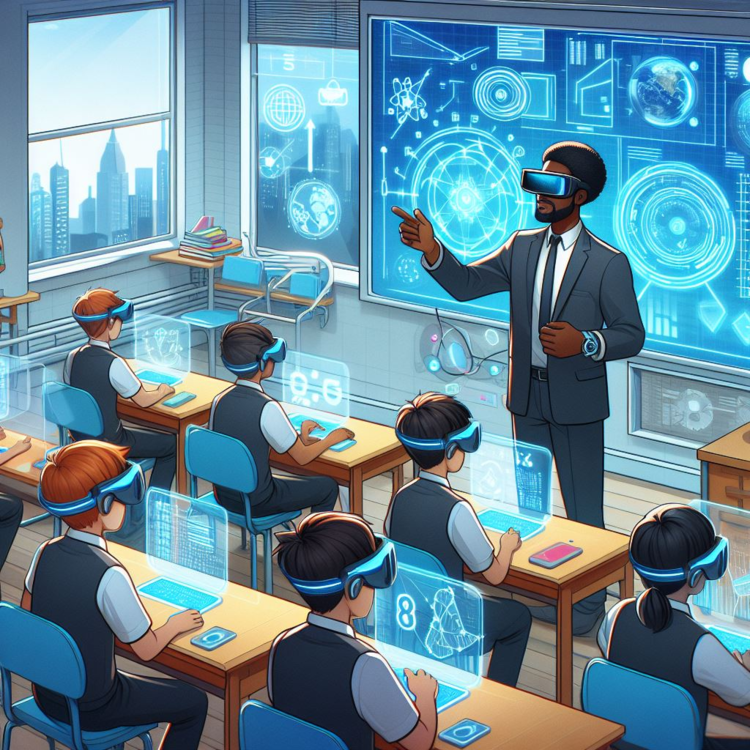Embarking on a journey through the corridors of education, we find ourselves at the intersection of innovation and pedagogy, where Virtual Reality (VR) and Augmented Reality (AR) converge to redefine the learning experience. Imagine a classroom where history comes to life, biology unfolds in three dimensions, and mathematical concepts materialize before your eyes. This isn’t the future—it’s the present, where immersive technologies are reshaping the landscape of education. Let us unravel the transformative power of VR and AR, exploring how these technologies engage students in ways never imagined. Join us on a captivating journey into the world of immersive education, where the boundaries of learning are limitless, and explore the latest trends in edtech:

Breaking the Classroom Walls:
Traditional classrooms often confine learning within four walls. However, immersive technologies like VR and AR expand the boundaries of education by transporting students to virtual worlds. Imagine stepping into ancient civilizations or traversing the cosmos—all from the comfort of a classroom.
By providing an immersive and interactive environment, these technologies not only capture students’ attention but also make learning more captivating and memorable.
Enhancing Retention Through Experiential Learning:
One of the most significant advantages of VR and AR in education is their ability to facilitate experiential learning. Instead of passively absorbing information, students can actively engage with complex concepts through simulated real-world scenarios.
For instance, in a biology class, students can virtually dissect a frog, gaining hands-on experience without the need for physical specimens. Similarly, history lessons can come alive as students immerse themselves in pivotal moments, making connections and deepening their understanding of historical events.
Personalized Learning Journeys:
Every student has a unique learning style and pace. VR and AR cater to individual needs by offering personalized learning experiences. Adaptive learning platforms can analyze students’ progress and adapt the curriculum accordingly, ensuring that each student receives tailored instruction.
Moreover, these technologies provide instant feedback, allowing students to track their progress and address areas of weakness in real-time. By empowering students to take control of their learning journey, VR and AR promote autonomy and self-directed learning.
Fostering Collaboration and Social Learning:
Education is not just about acquiring knowledge; it’s also about developing social and collaboration skills. VR and AR facilitate collaborative learning experiences, enabling students to work together irrespective of geographical barriers.
Whether it’s collaborating on group projects or embarking on virtual field trips, these technologies encourage teamwork and communication in a digital environment. By fostering collaboration, VR and AR prepare students for the collaborative nature of the modern workforce, where teamwork and communication are essential skills.
Engagement through Gamification:
Gamification has proven to be an effective strategy for increasing engagement and motivation in education. VR and AR leverage gamification elements to transform mundane lessons into exciting quests.
By incorporating points, rewards, and challenges, educators can gamify the learning experience, motivating students to actively participate and compete. Whether it’s solving puzzles, completing challenges, or earning virtual rewards, gamified learning experiences make education more enjoyable and rewarding for students.

Accessibility and Inclusivity:
One of the most significant advantages of immersive technologies in education is their ability to bridge gaps in accessibility. Virtual classrooms can be accessed from anywhere, allowing students to participate in learning activities irrespective of their physical location.
This level of accessibility promotes inclusivity, ensuring that all students have equal opportunities to engage with educational content. Additionally, VR and AR accommodate diverse learning needs, making education more accessible to students with disabilities or special educational needs.
Real-time Assessment and Feedback:
Assessment is an integral part of the learning process, providing educators with insights into students’ progress and understanding. VR and AR enable real-time assessment, allowing educators to monitor students’ performance and provide immediate feedback.
Adaptive learning platforms can analyze students’ interactions and adjust the difficulty level of tasks accordingly, ensuring that each student receives appropriate challenges. By providing timely feedback, VR and AR support students’ learning journey, helping them identify areas of improvement and celebrate their successes.
Cost-Effective Practical Training:
In fields like medicine or engineering, practical training is essential for developing hands-on skills. However, traditional practical training methods can be costly and resource-intensive. VR and AR offer cost-effective alternatives by simulating realistic training scenarios in a virtual environment.
For example, medical students can practice surgical procedures or engineering students can experiment with machinery—all without the need for expensive equipment or materials. By providing immersive and realistic training experiences, VR and AR prepare students for real-world challenges in their future careers.
Preparation for Future Careers:
The future workplace is rapidly evolving, with technology playing a pivotal role in driving innovation. By integrating VR and AR into education, educators can prepare students for the tech-driven workforce of tomorrow. Familiarity with these immersive technologies equips students with valuable skills, such as digital literacy, problem-solving, and adaptability.
Moreover, exposure to VR and AR environments helps students develop a comfort level in navigating virtual spaces, a skill that will be invaluable in future careers where remote work and virtual collaboration are becoming increasingly common.
Data-Driven Insights for Educators:
Data analytics is revolutionizing education, providing educators with valuable insights into students’ learning behaviors and preferences. VR and AR generate vast amounts of data on students’ interactions and performance, which can be analyzed to gain actionable insights.
Educators can identify trends, patterns, and areas of improvement, allowing them to make data-driven decisions to enhance teaching and learning outcomes. By harnessing the power of data analytics, VR and AR empower educators to personalize instruction, address individual learning needs, and drive continuous improvement in education.

Cultural Immersion for Global Awareness:
In today’s interconnected world, global awareness and cultural competence are essential skills for students. VR and AR can transport students to different parts of the world, providing them with immersive cultural experiences.
Whether it’s exploring historical landmarks, experiencing cultural festivals, or interacting with people from diverse backgrounds, these technologies foster global awareness and appreciation for cultural diversity. By breaking down geographical barriers, VR and AR promote a more interconnected and empathetic worldview among students, preparing them to thrive in a globalized society.
Addressing Different Learning Modalities:
Every student learns differently, and traditional one-size-fits-all approaches to education may not cater to diverse learning modalities. VR and AR offer a multi-sensory learning experience, accommodating visual, auditory, and kinesthetic learners.
Visual learners can benefit from immersive visualizations and 3D models, auditory learners can engage with interactive audio elements, and kinesthetic learners can interact with virtual objects and environments. By catering to different learning modalities, VR and AR ensure that all students can grasp and retain information effectively, promoting inclusivity and equity in education.
Motivating Disengaged Students:
Engaging disengaged students can be a challenging task for educators. However, VR and AR offer a unique opportunity to reignite students’ interest and motivation in learning. Interactive simulations, gamified experiences, and immersive storytelling captivate students’ attention, making learning more enjoyable and meaningful.
By providing interactive and hands-on learning experiences, VR and AR appeal to students’ curiosity and creativity, motivating them to actively participate in their education journey.
Simulating Professional Environments:
In vocational education and training, practical experience is crucial for developing industry-specific skills. VR and AR simulate realistic professional environments, allowing students to practice skills in a safe and controlled setting. For example, aspiring healthcare professionals can perform virtual surgeries, while future engineers can design and test prototypes in a virtual environment.
By providing hands-on experience in simulated professional settings, VR and AR prepare students for the challenges they will face in their future careers, ensuring that they are well-equipped to succeed in the workforce.
Ethical Dilemma Scenarios for Critical Thinking:
Critical thinking and ethical decision-making are essential skills for students to navigate complex ethical dilemmas in today’s society. VR and AR enable educators to present students with realistic ethical scenarios, allowing them to explore different perspectives and consequences.
By engaging in immersive ethical dilemma scenarios, students develop critical thinking skills, ethical reasoning, and empathy. These experiences encourage students to reflect on their values, beliefs, and moral principles, preparing them to make informed and ethical decisions in their personal and professional lives.
Conclusion:
Immersive technologies like VR and AR hold tremendous potential to revolutionize education and transform the learning experience. From breaking down the walls of traditional classrooms to fostering collaboration and critical thinking skills, these technologies offer a myriad of benefits for students and educators alike.
By providing personalized learning experiences, real-time assessment, and practical training opportunities, VR and AR empower students to reach their full potential and prepare them for success in the 21st-century workforce. As we continue to harness the power of immersive technologies in education, the possibilities are endless, promising a future where learning knows no bounds.

